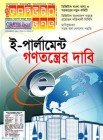হোম > iN2015 of Singapore vs Digital Bangladesh
লেখক পরিচিতি
লেখকের নাম:
আহমেদ হাফিজ খান
মোট লেখা:১৫
লেখা সম্পর্কিত
পাবলিশ:
২০০৯ - নভেম্বর
তথ্যসূত্র:
কমপিউটার জগৎ
লেখার ধরণ:
ডিজিটাল বাংলাদেশ
তথ্যসূত্র:
ইংরেজি সেকশন
ভাষা:
বাংলা
স্বত্ত্ব:
কমপিউটার জগৎ
iN2015 of Singapore vs Digital Bangladesh
Governments all over the world have chosen Information and Communication Technology to improve the efficiency and tap the potential of the power of the technology. The governments have created various categories of institutions with its frame work to promote ICT and derive the value of ICT. Bangladesh started its venture following the footprint of Singapore. National Computer Board was created in Singapore and Bangladesh during similar time in both the countries. The successful path of institutional capacity building and today’s Infocomm Development Authority of Singapore should be the model for Bangladesh, not the corrupt organizational model of ‘Directorate’.
History of IDA:
The Infocomm Development Authority of Singapore (IDA), a statutory board of the Singapore Government, was formed on 1 December 1999 when the government merged the National Computer Board (NCB) and Telecommunication Authority of Singapore (TAS), as a result of a growing convergence of information technology and telephony.
NCB History:
Prior to the merger, NCB, which was formed on 1 September 1981 under the auspices of the Ministry of Finance, one of the board’s most crucial functions was to implement the computerization of the civil service. NCB also served as the central authority in promoting, implementing and co-coordinating information s ystems development work in government ministries.
A Celebration of 25 Years of Infocomm in Singapore:
In 2006, Singapore celebrated 25 Years of infocomm development. The Government and the industry put together a series of activities that showcased the pioneering efforts that went into making Singapore a leading user of infocomm technology. One of these activities included a commemorative publication, titled “Innovationation : 25 Years of Infocomm in Singapore”. The publication comprises four books and traced the journey from when computerization started in 1981, to how convergence led to infocomm today. Lively illustrations, anecdotes and interviews with infocomm pioneers fill this definitive encyclopedia of Singapore’s infocomm legacy. For those who are interested to unveil the history, the books are available at all public libraries.
Overview :
IDA has a national role to identify and facilitate the adoption of infocomm technologies to enhance Singapore’s competitiveness. It fulfils this role by analyzing and monitoring the trends and development of infocomm technologies, as well as promulgating and encouraging the adoption of infocomm standards in Singapore.
Backed by its strong domain knowledge of how infocomm can be applied to the vertical sectors of the economy, IDA is well placed to function as the national Infocomm champion. It has also deployed - and continually upgrades - a pervasive and robust infocomm infrastructure, for the effective deployment and adoption of infocomm as a key economic driver.
To provide a conducive environment that facilitates the growth of key industry sectors and to encourage infocomm adoption, IDA has an array of programs to meet industry needs and develop new areas of growth.
Education :
Singapore intends to strategically deploy infocomm technology (ICT) in education to provide a learner-centric and collaborative learning environment that extends beyond the classrooms. To create such an environment, IDA is spearheading the thrust towards ICT adoption in the following areas:
Including dynamic digital content as critical components integrated with approved curriculum and learning resources for flexible learning and interactivity.
Empowering students by providing easy access to content, applications, fellow students and guidance from teachers.
Enabling learning beyond the school so that the student is able to learn anytime, anywhere.
Financial Services :
As financial services are information and technology intensive in nature, technology will play a key role in shaping the way the financial institutions transform their businesses and infuse their legacy operating models with unprecedented functionality. Singapore’s strengths in infocomm and market infrastructure will provide a comparative advantage to capture the emerging growth opportunities for financial services in Asia.
Healthcare:
Healthcare is an information intensive sector with complex care delivery processes and effective use of patients’ medical data and direct integration of lab results would help increase quality of healthcare, minimise medical errors and lower cost. Through the use of infocomm, patients’ medical information can be better managed and made accessible to healthcare providers at all points-of-care. Infocomm can also enable the re-engineering of processes and workflows through the development of a patient-centred and hassle-free healthcare delivery system to address the current challenges faced by the sector.
IDA actively engages healthcare institutions and the infocomm industry to develop innovative applications for the sector to improve the quality of healthcare provided, lower cost, increase productivity as well as to enable the paradigm shift in healthcare delivery.
Manufacturing & Logistics :
IDA aims to turn Singapore into a high value manufacturing hub and supply chain nerve centre, powered by infocomm. The Collaborative High-Tech Manufacturing Plan was conceived by IDA to develop integrated and responsive high-tech manufacturing supply chains in Singapore, linked by ICT and providing end-to-end services from product design to customer management. It aims to build dynamic end-to-end collaborative supply chains through the use of ICT as a strategic tool.
Tourism, Hospitality & Retail :
In a high-touch service industry like our Tourism, Hospitality and Retail (THR) sector, infocomm can be exploited to create new ways of delivering better services to visitors and customers. It can also help to improve the efficiency of the companies and operators in the THR sector, thereby enhancing service, enriching experience and differentiating Singapore to further entrench Singapore’s attractiveness as a travel and shopping destination of choice.
Government :
Championing ICT adoption in the government sector are the eGovernment Policies & Programs Division (EPPD) and the Government Infrastructure & Technology Division (GITD). Together they architect and plan government infrastructures that meet the changing needs of the public service, and manage cum operate these infrastructures efficiently and effectively.
The action plans for e-Government have evolved in tandem with each National IT plan to bring about exciting changes to the way Singapore Government works, interacts and serves the public.
Small & Medium-Sized Enterprises:
To expand and grow business, SMEs can make use of infocomm technology to promote your products and services anywhere without having to be there physically and improve operations.
Community:
As our future becomes more and more digitally-driven, particularly with the iN2015 vision to turn Singapore into an Intelligent Nation, infocomm becomes a powerful leveler that can help the needy, the elderly and the disabled enrich their quality of life. IDA’s aim is to bridge the digital divide and create an integrated society in Singapore where infocomm awareness is pervasive and infocomm access is available for one and all.
Bangladesh Scenario:
The status of ICT in Bangladesh is synonymous to the status of the Bengalis under Pakistani regime. The sector and Bangladesh Computer Council was ignored by the bureaucrats from the inception but when the Awami League government announced Vision 2021 – Digital Bangladesh the conspiracy to eradicate ICT is being hatched. Number of corrupts have interest in making money out of the marked for Digital Bangladesh. Singapore government has empowered its NCB to grow while Bangladesh is planning to take backward steps to degrade BCC to a Directorate. The flexibility provided in the BCC Act 1990 is good to realize the goal of Digital Bangladesh similar to iN2015. Intelligent Nation 2015 (iN2015) is Singapore’s 10-year master plan to help us realize the potential of infocomm over the next decade. Led by the Infocomm Development Authority of Singapore (IDA), iN2015 is a multi-agency effort that is the result of private, public and people sector co-creation. The goals of Singapore’s iN2015 are:
* to be member 1 in the world in harnessing infocomm to add value to the economy and society
* to realise a 2 – fold increase in the value-add of the infocomm industry to S$26 billion
* to realise a 3 – fold increase in infocomm export revenue to S$60 billion
* to create 80,000 additional jobs
* to achieve 90% home broadband usage
* to achieve 100% computer ownership in homes with school-going children
The Government of Bangladesh must carefully choose the path of Digital Bangladesh at this critical juncture of time. It must choose the successful path of Singapore, Malaysia, India etc. rather than the path of betrayal and conspiracy charted by the greedy few in the bureaucracy. The government must realize that the bygone are the eras of Mughal & Colonial Rule with the dawn of Information & Communication Technology (ICT). The new era of ICT requires knowledge based lightning fast decision and flexible empowered organizations like IDA of Singapore. The goal can be achieved through empowering BCC not through degrading an autonomous organization like BCC to a directorate.
Acknowledgements: IDA & BCC publication and information available in the web.
CJ WEB
Feedback ahafizkhan@rocketmail.com
লেখাটি পিডিএফ ফর্মেটে ডাউনলোড করুন
লেখাটির সহায়ক ভিডিও
পাঠকের মন্তব্য
২০০৯ - নভেম্বর সংখ্যার হাইলাইটস
অনুরূপ লেখা




